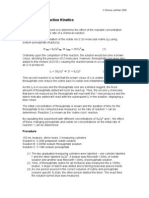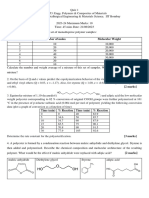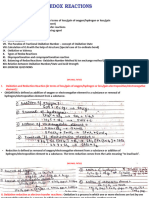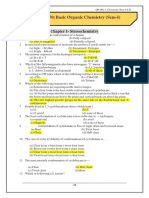Kinetics Lab Report
Kinetics Lab Report
Uploaded by
Ronan ReyesCopyright:
Available Formats
Kinetics Lab Report
Kinetics Lab Report
Uploaded by
Ronan ReyesOriginal Title
Copyright
Available Formats
Share this document
Did you find this document useful?
Is this content inappropriate?
Copyright:
Available Formats
Kinetics Lab Report
Kinetics Lab Report
Uploaded by
Ronan ReyesCopyright:
Available Formats
lOMoARcPSD|8461731
Kinetics Lab Report
Comprehensive General Chemistry 3 (University of Chicago)
StuDocu is not sponsored or endorsed by any college or university
Downloaded by Lin • (rtreyes06@gmail.com)
lOMoARcPSD|8461731
Kinetics: "Iodine Clock" Lab Report
Introduction: In order to describe the chemical kinetics of a reaction, it is desirable to determine
how the rate of reaction varies as the reaction progresses. The rate law is a mathematical
equation that describes the progress of the reaction and has the following general form for the
reaction aA + bB --> cC + dD:
rate = -d[A]/(a(dt)) = k[A]m[B]n
[A] and [B] are concentrations of the reactants and k is the rate constant. The variables m , n
and k can only be determined experimentally. In this experiment, the oxidation reaction of
iodide by peroxydisulfate is performed. The rate law for this reaction is as follows:
rate = -Δ[S2O82-]/Δt = k[I-]m[S2O82-]n
This lab provides an opportunity to understand different concepts of chemical kinetics such as
the reaction rate, rate constant, and reaction order. In this lab-- using several mixtures of the
iodide and peroxydisulfate solutions-- it is possible to calculate the reaction order and the
reaction constant of the chemical reaction. By manipulation of temperature, it is also possible to
understand the temperature dependence of the rate constant as well as determine the activation
energy of the reaction using an Arrhenius plot. Understanding chemical kinetics is important
because of its practical applications. For example, understanding rates of reaction is important
in the manufacturing of ammonia for fertilizer using the Haber process. If the reaction to produce
ammonia is conducted at a low temperature, the rate of reaction will be too slow. Because the
manufacturers want to produce as much fertilizer as possible, they must manipulate the
temperature to produce a satisfactory rate.
Experimental: F
or the first portion of this experiment, 5 "Mixtures" are prepared, with varying
concentrations of solutions; the concentrations are summarized in the following table:
Mixture # I- (0.20M) SO42- S2O32- (0.01M) Starch (drops) H2O S2O82-(0.14M)*
(0.33M)
1 50 25 10 10 5 10
2 25 30 10 10 25 10
3 10 33 10 10 37 10
4 10 27 10 10 28 25
5 10 16 10 10 14 50
Downloaded by Lin • (rtreyes06@gmail.com)
lOMoARcPSD|8461731
All of the solutions amounts are in mL, except starch. Combine all of these solutions, except
S2O82- into a beaker and bring the Mixture to room temperature in a water bath. Separately heat
S2O82- in the same bath. Once the Mixture and S2O82- reach the same temperature, combine the
two while on a magnetic stir plate and begin recording the time on a stopwatch. After stirring for
ten seconds, return the combined Mixture to the bath and stop the stopwatch once the Mixture
reaches a blue color.
For the second portion of this experiment, repeat the above procedure with three volumes of
Mixture 4. Run the same experiment, but in a 10 ℃, 30 ℃, and 40 ℃ bath for trials 1, 2, and 3,
respectively (we don't need to do 20 ℃ because our room temperature trial in the first part of the
experiment serves as our data point).
Record the initial and final temperature for every trial; take note of qualitative observations at
each step and dispose of each solution in the Iodine waste bin.
[No deviations were made from UChicago General Chemistry Lab Manual]
Data Analysis:
Qualitative
For all mixtures, once the peroxydisulfate was added the solutions turned from clear to blue
after a certain amount of time Δt.
Quantitative
Table 1: Rate of Reaction for Each Mixture
Mixture # Tinitial (℃)
Tfinal (℃)
Δt (s) -Δ[S2O82-]/Δt (M/s)
1 19.6 19.6 83 6.02E-6
2 19.8 19.3 158 3.16E-6
3 19.9 19.8 398 1.26E-6
4 19.5 19.7 202 2.48E-6
5 19.6 19.8 97 5.15E-6
Sample Calculation; -Δ[S2O82-]/Δt, Mixture 1:
Moles of S2O32- = 0.10L x .01M = .0001 mol S2O32- x (1 mol S2O82-/1 mol S2O32-) =
.00005 mol S2O82-/0.10L = .0005M S2O82-
.0005M S2O82-/83s = 6.02E-6 M/s
Downloaded by Lin • (rtreyes06@gmail.com)
lOMoARcPSD|8461731
Table 2: Relationship Between Iodide Concentration and Rate
Mixture # [I-] (M) -Δ[S2O82-]/Δt (M/s) log([I-]) log(-Δ[S2O82-]/Δt (M/s))
1 0.10 6.02E-6 -1.0 -5.22
2 0.050 3.16E-6 -1.3 -5.50
3 0.020 1.26E-6 -1.7 -5.90
Sample Calculation; [I-], Mixture 3:
0.010L x .20M = .002 mol I-/.10L = .020M I-
log(.020M) = -1.7
Figure 1: Relationship Between Iodide Concentration and Rate
Table 3: Relationship Between Peroxydisulfate Concentration and Rate
Mixture # [S2O82-] (M) -Δ[S2O82-]/Δt (M/s) log([S2O82-]) log(-Δ[S2O82-]/Δt) (M/s))
3 0.014 1.26E-6 -1.9 -5.90
4 0.035 2.48E-6 -1.5 -5.61
5 0.070 5.15E-6 -1.2 -5.29
Sample Calculation; [S2O82-], Mixture 4:
Downloaded by Lin • (rtreyes06@gmail.com)
lOMoARcPSD|8461731
0.25L x 0.14M = 0.0035 mol/0.1L = .035 mol S2O82-
log(.035) = -1.5
Figure 2: Relationship Between Peroxydisulfate Concentration and Rate
Table 4: Raw Data for Each Temperature
Target Temperature Tinitial (℃)
Tfinal (℃)
Δt (s)
(℃)
10 11.0 11.0 253
20 19.5 19.7 202
30 27.1 27.1 105
40 39.0 39.0 43
Table 5: Relationship Between Temperature and Rate
Target T (℃) Average T (℃) Δt (s) -Δ[S2O82-]/Δt (M/s) k(T)
Downloaded by Lin • (rtreyes06@gmail.com)
lOMoARcPSD|8461731
10.0 11.0 253 1.98E-3 1.63E-3
20.0 19.6 202 2.48E-6 2.04E-6
30.0 27.0 105 4.76E-6 3.92E-6
40.0 39.0 43 8.93E-6 7.35E-6
Sample Calculation; m and kb:
log(-Δ[S2O82-]/Δt) = log(kb) + m x log([I-])
From Figure 1... y = 0.972x - 4.24
m = 0.972
kb = 10-4.24 = 5.75E-5
Sample Calculation; n and ka:
log(-Δ[S2O82-]/Δt) = log(ka) + n x log([S2O82-])
From Figure 2... y = 0.868x - 4.31
n = 0.868
ka = 10-4.31 = 4.90E-5
Sample Calculation; k:
ka = k[I-]m
k = (4.9E-5)/(0.0200.972)
k = 2.20E-3
kb = k[S2O82-]n
k = (5.75E-5)/(0.0140.868)
k = 2.34E-3
Average k = 2.27E-3
Sample Calculation; k(T), 10.0 ℃:
rate = -Δ[S2O82-]/Δt = k[I-]m[S2O82-]n
1.98E-6 = k(0.020)0.972(0.035)0.868
k(10 ℃) = 1.63E-3
Table 6: Different Logarithms of Various Rate Constants
T (℃) T (K) 1/T (K-1) k(T) log(k) ln(k)
11.0 284.15 3.52E-3 1.63E-3 -2.79 -6.42
Downloaded by Lin • (rtreyes06@gmail.com)
lOMoARcPSD|8461731
19.6 292.75 3.42E-3 2.04E-3 -2.69 -6.19
27.1 300.25 3.33E-3 3.92E-3 -2.41 -5.54
39.0 312.15 3.20E-3 7.35E-2 -2.13 -4.91
Figure 3: Arrhenius Plot of Table 6
Sample Calculations, Arrhenius Plot:
ln(K) = ln(A) - (Ea/R)(1/T)
From Figure 3... y = -4999x + 11.1
A = e11.1 = 6.62E4
Ea = -4999 x -8.314 = 41561 J = 41.56 kJ
Discussion: In this lab, the rate constant was determined to be .00227 L mol-1 s-1. In addition, the
order of the reaction were calculated to be m = 0.972 and n = 0.868 and the total order is 1.840.
This results in the overall rate expression: rate = [I-]0.972[S2O82-]0.868. Because the rate constant is
dependent on the temperature, this rate expression is only applicable at room temperature.
Although there aren't perfectly-defined "known values" for the reaction orders, both m and n are
supposed to be ~1. Both our m and n values were relatively close to this value. We 0.868 for our
n value, a 13.2% error; meanwhile, we got 0.972 for our m value, a 3.8% error. The overall rate
of 1.840 deviates from the approximate "known" value of 2 by 8.0%.
Figure 3 illustrates the effect of temperature on the rate constant; as temperature increases, the
rate constant increases for this reaction. Also, by determining the rate of reaction for different
Downloaded by Lin • (rtreyes06@gmail.com)
lOMoARcPSD|8461731
temperatures for Mixture 4, it was possible to calculate the activation energy. Using the
Arrhenius plot (figure 3) and the equation, ln(K) = ln(A) - (Ea/R)(1/T), the activation energy was
computed to be 41.6 kJ/mol.
There are several possible sources of error that could affect our rate constant and activation
energy calculations. Determining when the reaction was complete was problematic. It was
uncertain whether the first presence of blue signified the end of the reaction or the presence of
blue throughout the solution signified the end. This discrepancy affects the change in time,
which affects the calculation both the rate constant and the activation energy. We waited until
the entire solution was blue, which could have consistently overestimated our reaction times
and consequently underestimated our rates. Another possible source was the variation of
temperature for each sample. In order to produce accurate rate constants, the temperature must
remain constant for the entire reaction. It is possible to keep the temperature constant by
observing the temperature and adding ice or boiling water to the bath as needed. The presence
of unwanted ions in solutions can also have an affect on calculations. The presence of metal
ions such as copper, even at small concentrations, can catalyze the reaction. In each mixture, a
different concentration of tap water was added with different concentrations of unwanted ions.
This error can be avoided by adding a complexing agent like sulfate and using distilled water,
which is available but unreliable in our lab.
Considering the consequences of the kinetic salt effect, sulfate solution was added to all
mixtures in the experiment. The kinetic salt effect is effect of the salts in solution on the rate of
reaction. When reactions involving ionic compounds occur in solution, the addition of a salt can
speed up, slow down or have no effect on the rate of reaction. Depending on the preexisting
ionic strength of the solution, a certain amount of sulfate solution is added to each mixture to
keep constant the ionic strength for all mixtures. In Mixture 1, the moles of sulfate were 0.025L x
.33M = 0.00825 moles. In mixture 2, 3, 4, and 5 the moles of sulfate were 0.0099, 0.0109,
0.00891, and .00528, respectively.
The bath temperature changes only slightly because of the high specific heat of water. The
equation q = mcΔT illustrates the reasons why it is difficult to effect the temperature significantly.
Because the mass of the bath is large and the specific heat of water is relatively large, the
samples would need a large amount of heat energy to produce a large change in temperature.
Conclusion: This lab provided an opportunity to experimentally determine the rate constant and
the order of the reaction in which iodide was oxidized by peroxydisulfate reaction. In this lab, the
rate constant was determined to be .00227 L mol-1 s-1 and the total order of the reaction was
1.840. The overall rate expression was rate = [I-]0.972[S2O82-]0.868. The "correct' values for the m
and n of this reaction are approximately 1; we got quite close to these values. The effect of
temperature on the rate of constant was also examined in this lab. Plotting these effects
produced an Arrhenius plot that was used to derive the activation energy for the reaction of 41.6
kJ/mol. There were some sources of error like the endpoint of the reaction, the variations in
temperature, and the presence of interfering ions. It was difficult to determine which shade of
Downloaded by Lin • (rtreyes06@gmail.com)
lOMoARcPSD|8461731
blue signified the end of the reaction. It was also difficult to keep the temperature constant for
the temperature portion of the lab. Having a supply of ice and boiling water could aid in
minimizing variations. The variations of the temperature were not an issue for the room
temperature portion because the bath water had a large mass and the specific heat of water is
relatively large. Finally, the presence of ions like copper could catalyze the reaction. This
unwanted effect could be reduced by using a complexing agent or by using distilled water.
Another source of error was the effect of ionic strength on the rate of reaction. The sulfate was
added to keep the ionic strength equal for all mixtures.
Sources Cited:
1. Zhao, Meishan and Dragisich, Vera. General Chemistry Experiments. Hayden-McNeil
Macmillan Learning, 2018.
Downloaded by Lin • (rtreyes06@gmail.com)
You might also like
- Hydrolysis of Methyl AcetateDocument7 pagesHydrolysis of Methyl AcetateKuo Sarong100% (3)
- MT 304 - Gas Liquid Absorption: CL 333 Chemical Engineering Lab-III (2021)Document13 pagesMT 304 - Gas Liquid Absorption: CL 333 Chemical Engineering Lab-III (2021)Shivansh SinghNo ratings yet
- Experiment 1 Lab ReportDocument9 pagesExperiment 1 Lab ReportRowlandNo ratings yet
- Lab Report g1 Exp.2 (A) CHM 213 2020Document8 pagesLab Report g1 Exp.2 (A) CHM 213 2020Muhd Mirza Hizami100% (1)
- Kinetics: Initial Rates Method: Experiment OneDocument11 pagesKinetics: Initial Rates Method: Experiment OnePrudenceNo ratings yet
- Calculate KM and Vmax From The Following DataDocument6 pagesCalculate KM and Vmax From The Following DataDr-Dalya Shakir0% (1)
- Iodine Clock Reaction KineticsDocument3 pagesIodine Clock Reaction KineticsDionee Liefman100% (5)
- A. Tabel Data PengmatanDocument4 pagesA. Tabel Data PengmatanAdinda NurNo ratings yet
- Reaction+Rate+and+Kinetics Part1 CleanDocument28 pagesReaction+Rate+and+Kinetics Part1 Cleanandreamcarthur2No ratings yet
- Chemrj 2017 02 04 78 83Document6 pagesChemrj 2017 02 04 78 83editor chemrjNo ratings yet
- CM 1502 Lab 2Document15 pagesCM 1502 Lab 2i000years100% (1)
- 2013 - REEN3001 - Catalytic Processes - December2013AlternateDocument5 pages2013 - REEN3001 - Catalytic Processes - December2013Alternatesharon khanNo ratings yet
- Interactive TD 280: Compensation of Oxygen MeasurementsDocument17 pagesInteractive TD 280: Compensation of Oxygen MeasurementsHariNo ratings yet
- Heat of Solutions and SolubilityDocument25 pagesHeat of Solutions and SolubilityDanielNo ratings yet
- Esterification of Ethanol in A Batch Reactor in Presence of H2SO4Document17 pagesEsterification of Ethanol in A Batch Reactor in Presence of H2SO4MD.Khairul EducationNo ratings yet
- Group No. (4) Exp. No. (11) Date:-17/12/2008 Exp Name: - Chemical KineticsDocument4 pagesGroup No. (4) Exp. No. (11) Date:-17/12/2008 Exp Name: - Chemical Kineticsشركة العاصمة لخدمات التنظيفNo ratings yet
- CHM270 Report 6 - KineticsDocument6 pagesCHM270 Report 6 - KineticsGeorges MaaloufNo ratings yet
- Kimia Fisik A 440871 Fadhlih Al-Zaki Sitorus PDFDocument7 pagesKimia Fisik A 440871 Fadhlih Al-Zaki Sitorus PDFFadhlih Al-zakiNo ratings yet
- Chemical KineticsDocument22 pagesChemical KineticsEleanorNo ratings yet
- 2013 - REEN3001 - Catalytic Processes - December2013Document6 pages2013 - REEN3001 - Catalytic Processes - December2013sharon khanNo ratings yet
- Chemical KineticsDocument7 pagesChemical Kinetics2021ph07No ratings yet
- CRE LAB Copy Experiment3Document9 pagesCRE LAB Copy Experiment3M A R k H O RNo ratings yet
- CHM1207 Lab 4 - Students ReportDocument6 pagesCHM1207 Lab 4 - Students ReportNatalia ReddyNo ratings yet
- Quiz 1 With AnswerDocument3 pagesQuiz 1 With AnswerAltra ZNo ratings yet
- T2 EosDocument17 pagesT2 EosKush ShahNo ratings yet
- Report 7 Kinetics Chem270Document5 pagesReport 7 Kinetics Chem270charbelyusef17sNo ratings yet
- Exp 1 Catalyst ReportDocument11 pagesExp 1 Catalyst ReportMohammed Salah JamalNo ratings yet
- 6729644010_parima_lab8Document6 pages6729644010_parima_lab81.33 พริมา Parima Duidui BodharamikNo ratings yet
- Convecção Forçada - G6Document9 pagesConvecção Forçada - G6Julia CellaNo ratings yet
- Band Gap of CuODocument8 pagesBand Gap of CuOBilal JuttNo ratings yet
- lab 19Document6 pageslab 19xiaoyansu1233No ratings yet
- Data MiningDocument7 pagesData MiningPavan KoteshNo ratings yet
- The Rate of Reaction of Iodide Ion With Hydrogen Peroxide: Chemical Kinetics Via A "Clock" ReactionDocument3 pagesThe Rate of Reaction of Iodide Ion With Hydrogen Peroxide: Chemical Kinetics Via A "Clock" Reactionapi-25776375100% (1)
- Metodo DiferenciacionDocument6 pagesMetodo DiferenciacionIbarra ChavezNo ratings yet
- Iodine Kinetics Clock ReactionDocument6 pagesIodine Kinetics Clock ReactionribotsNo ratings yet
- Lab 6Document6 pagesLab 6Khuresh ShahNo ratings yet
- DataDocument18 pagesDataMohaiminNo ratings yet
- Formula Sheet Ctb3365Dwx - Drinking Water: Element Atomic Mass Element Atomic MassDocument2 pagesFormula Sheet Ctb3365Dwx - Drinking Water: Element Atomic Mass Element Atomic MassGiancarlo Raúl Manrique VillarrealNo ratings yet
- Terminal VelocityDocument13 pagesTerminal VelocityLAURA ANDREA HOYOS BELTRANNo ratings yet
- Tugas Pertemuan 7 - Gasal 23-24Document5 pagesTugas Pertemuan 7 - Gasal 23-24Feri Adi SaputraNo ratings yet
- E1Document11 pagesE1Boyce NgomaNo ratings yet
- Streeter Phelps Oxygen Sag ModelDocument6 pagesStreeter Phelps Oxygen Sag ModelMariari KelvinNo ratings yet
- International Journal of Chemtech ResearchDocument7 pagesInternational Journal of Chemtech ResearchIrfandyNo ratings yet
- Assignment - 01 - SEC - B - GROUP No. 11Document14 pagesAssignment - 01 - SEC - B - GROUP No. 11RahulTiwariNo ratings yet
- Chemical Kinetics ExercisesDocument2 pagesChemical Kinetics ExercisesBanana CrazyNo ratings yet
- Experiment 2 Report: e D ?rospeerDocument2 pagesExperiment 2 Report: e D ?rospeerandrewNo ratings yet
- Unit 4 Review Reaction Rates Answers To ReviewDocument8 pagesUnit 4 Review Reaction Rates Answers To ReviewANGELYN SANTOSNo ratings yet
- MT 304 - Gas Liquid Absorption: CL 333 Chemical Engineering Lab-III (2021)Document13 pagesMT 304 - Gas Liquid Absorption: CL 333 Chemical Engineering Lab-III (2021)Shivansh SinghNo ratings yet
- Tabel RBLDocument5 pagesTabel RBLkalalo raffyNo ratings yet
- Munn - Metal-Organic Frameworks SIDocument10 pagesMunn - Metal-Organic Frameworks SIjeppoo1No ratings yet
- Objective:: σ and hasDocument9 pagesObjective:: σ and hasfareeha saeedNo ratings yet
- 1.1 Saturator 1.1.1 Process Description: H O From Distillation ColumnDocument20 pages1.1 Saturator 1.1.1 Process Description: H O From Distillation ColumnNUR AKMAL HISHAMNo ratings yet
- Experiment 5: Factors Affecting Reaction Rate: International University, Vietnam National University - HCMC 1Document8 pagesExperiment 5: Factors Affecting Reaction Rate: International University, Vietnam National University - HCMC 1NaHuynJungNo ratings yet
- Core Chemistry - Experiment 3Document12 pagesCore Chemistry - Experiment 3Manda BaboolalNo ratings yet
- Tugas Geokimia GeothermalDocument4 pagesTugas Geokimia GeothermalBagus PrabaswaraNo ratings yet
- 2014 - REEN3001 - CatalyticProcesses - April 2014Document5 pages2014 - REEN3001 - CatalyticProcesses - April 2014sharon khanNo ratings yet
- Kurva Hubungan Antara Konsentrasi Larutan Na S O Dengan Waktu (1/t)Document2 pagesKurva Hubungan Antara Konsentrasi Larutan Na S O Dengan Waktu (1/t)Mulia Sri RahmawatiNo ratings yet
- Lab 4Document11 pagesLab 4Auni AfiqahNo ratings yet
- Kinetics of An Iodine Clock ReactionDocument10 pagesKinetics of An Iodine Clock ReactionAshley Straub100% (1)
- Perhitungan Panas Dari Pelepas Panas Reaksi:: Reaksi 2 C2H6 + 3.5 O2 M: 0 0 RX: 0 0 S: 0 0Document10 pagesPerhitungan Panas Dari Pelepas Panas Reaksi:: Reaksi 2 C2H6 + 3.5 O2 M: 0 0 RX: 0 0 S: 0 0Evi diah phitalokA100% (1)
- Gas Hydrates 1: Fundamentals, Characterization and ModelingFrom EverandGas Hydrates 1: Fundamentals, Characterization and ModelingDaniel BrosetaNo ratings yet
- Final 2018 Answer KeyDocument18 pagesFinal 2018 Answer Keydaeh2thefreeNo ratings yet
- Adv. Synth. Catal. 2023, 365, 104-109Document6 pagesAdv. Synth. Catal. 2023, 365, 104-109RohanNo ratings yet
- Kaneda Cu-Free Wacker Oxidation of Internal Olefins ACIEE 2010Document3 pagesKaneda Cu-Free Wacker Oxidation of Internal Olefins ACIEE 2010Victor CiocalteaNo ratings yet
- 2019 Cre Ii L24-26Document32 pages2019 Cre Ii L24-26Aman PrasadNo ratings yet
- R (DC /DT) 0.2 Mol L C: ASSIGNMENT #2 - Reaction Kinetics 2Document2 pagesR (DC /DT) 0.2 Mol L C: ASSIGNMENT #2 - Reaction Kinetics 2AndreNo ratings yet
- Types of Chemical Reactions - QuestionsDocument2 pagesTypes of Chemical Reactions - Questionslon.bar.27No ratings yet
- Retrosynthesis Aspirin 1Document3 pagesRetrosynthesis Aspirin 1Nimra YounasNo ratings yet
- Lecture Notes-1Document16 pagesLecture Notes-1blublu.007No ratings yet
- QB - Haloalkane and HaloareneDocument2 pagesQB - Haloalkane and HaloareneSameer KumarNo ratings yet
- Design For Parallel Reactions (Compatibility Mode)Document8 pagesDesign For Parallel Reactions (Compatibility Mode)Jeetendra YadavNo ratings yet
- Zealstudy: Science 10. Types of Chemical Reactions Class: 10 Small Test Marks: 30 I Choose The Correct Answer 10 × 1 10Document1 pageZealstudy: Science 10. Types of Chemical Reactions Class: 10 Small Test Marks: 30 I Choose The Correct Answer 10 × 1 10santhoshsanthosh20202021No ratings yet
- Unit Six Kinetics SL Paper Two Work SheetDocument21 pagesUnit Six Kinetics SL Paper Two Work SheetKays Abu einNo ratings yet
- CHY3201 T8 Elimination ReactionsDocument16 pagesCHY3201 T8 Elimination ReactionsNURIN JAZLIENA BINTI HAZIZAN / UPMNo ratings yet
- Types of Reaction Reagents Conditions Organic Products Side ProductsDocument2 pagesTypes of Reaction Reagents Conditions Organic Products Side ProductsFakhar LateefNo ratings yet
- Chemistry DLP Final 1Document13 pagesChemistry DLP Final 1benieisrael.iiNo ratings yet
- Lecture 6 - Enzymes As Drug TargetsDocument31 pagesLecture 6 - Enzymes As Drug TargetsAlex LesNo ratings yet
- Wacker Process Slides 2008Document5 pagesWacker Process Slides 2008Zakariya AdamNo ratings yet
- CH-150: Basic Organic Chemistry (Sem-I) : Chapter 1-StereochemistryDocument11 pagesCH-150: Basic Organic Chemistry (Sem-I) : Chapter 1-StereochemistryRajesh PatilNo ratings yet
- Chapter 2: Diagnostic Enzymology: E+S Es E+PDocument87 pagesChapter 2: Diagnostic Enzymology: E+S Es E+PDereje KasuNo ratings yet
- Organic Chemistry Named ReactionDocument2 pagesOrganic Chemistry Named ReactionSHIVESH singhNo ratings yet
- Chemistry Form 5Document3 pagesChemistry Form 5alliey75% (8)
- Carvalho Silva2016Document5 pagesCarvalho Silva2016kasun1237459No ratings yet
- The 2021 Nobel Prize in ChemistryDocument1 pageThe 2021 Nobel Prize in ChemistrySaidul Islam RupokNo ratings yet
- Exp 7Document5 pagesExp 7zanjinyadzaNo ratings yet
- Lecture Notes Chemistry 342-2008 Mukund P. Sibi: AlphaDocument3 pagesLecture Notes Chemistry 342-2008 Mukund P. Sibi: AlphaAyeshaNo ratings yet
- Adv Synth Catal - 2021 - Xiao - Access To Triazolopiperidine Derivatives Via Copper I Catalyzed 3 2 CycloadditionDocument4 pagesAdv Synth Catal - 2021 - Xiao - Access To Triazolopiperidine Derivatives Via Copper I Catalyzed 3 2 CycloadditionSomnath GhoshNo ratings yet
- 029) Reactive IntermediatesReactionmechanismDocument111 pages029) Reactive IntermediatesReactionmechanismp23238913No ratings yet
- Tutorial 1Document3 pagesTutorial 1Aakash R RajwaniNo ratings yet
- Chemical Reaction EngineeringDocument3 pagesChemical Reaction Engineeringali AbbasNo ratings yet

























































































